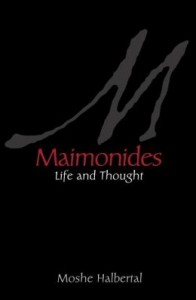 High praise for English version of Maimonides book
High praise for English version of Maimonides book
By Professor Arnold Ages
Maimonides: Life and Thought. By Moshe Halbertal. Translated from the Hebrew by Joel Linsider. Princeton University Press. 2014. 385 Pages.
As Voltaire once observed – The Bible is plus célèbre que connu – The Bible is more celebrated than known – a comment which can also be applied to that great eagle of Jewish learning Moshe ben Maimon, Maimonides (1135–1204). There is a huge library of books, articles and monographs written about this philosopher – the bibliography is enormous and yet few people, outside of the university specialist or in Yeshiva community, can discuss his major works.
That situation will be changing now with the publication by Moshe Halbertal of his game changing volume on Maimonides which is blazing new intellectual horizons for its comprehensiveness, its philosophical depth, its chronological accuracy, its biographical detail and – most important of all – the English version. This executed by Joel Linsider is one of the most lucid translations of any philosophical work I have encountered. It is too bad that Linsider, who died shortly after the translation was completed, did not have an opportunity to translate Descartes or Heidegger into intelligible English! I have the greatest respect for translators for they are the major diplomats of our age – ambassadors who translate the culture of one civilization into another.
Halbertal divides his opus into chapters, dealing, among other things, with Maimonides’ life in Spanish and Arab cultures, his concern with the Jews of Yemen and the challenge of Islam. Chapter two deals with the commentary on the Mishneh, the great code of Jewish law, the idea of revelation, and the tensions between the latter and Jewish law. In his third chapter he explores the great sage’s views on immortality, resurrection, ethics and the idea of saintliness in Jewish tradition. Linsider’s translation of chapter four of Halbertal’s essay is a vivid explanation of what Halakhah – Jewish law – actually is and how the authority of the rabbis is maintained. Similarly the following chapter illumines the deeply troubling views of Maimonides on creation, prophecy, faith and Jewish chosenness. Chapter six pivots on the form and content of Jewish law and the connection between law and Jewish sources in the Talmud.
Chapter seven is Halbertal’s effort to explain the authorial voice in The Guide to the Perplexed and how it can be read on several different levels. Chapter eight is a further meditation on the Guide and how it deals with prophecy, the presence of evil and the reasons for the commandments. In each of these chapters the author provides a clear and comprehensive review of the issues at hand. Halbertal uses his access to the storehouse of the Cairo Geniza to unfold many of the problems which occupied Jews. His readings of Maimonides’ Responsa, that is to say, the answers to questions posed to him, show that early in his career he was very impatient with people who conceived of the deity in human terms or who used astrology – both errors, he believed were tantamount to idol worship.
One of the other issues explored is his Iggeret Teman, the Letter to the Jews of Yemen, which is featured is several older editions of siddurim (prayer books); it is Maimonides’ excursion into the field of comparative religion. There he counsels the Yemenite Jews with regards to the pressure they live under the dominion of Islam. His preamble to the question includes a comparison of both Christianity and Islam with Judaism, and points out that while Islam is a monotheistic faith and Christianity is one tainted with violations of that doctrine through Trinitarian beliefs, Islam is a greater menace to Judaism – why? Because Christianity, while hostile theologically to Judaism, still reveres Jewish Scripture; Islam, however, deems that Scripture to be a forgery and hence is a threat to Judaism. He then urges Yemenite Jews to honor the permanence of the covenant between G-d and His people and to remember that it is the final revelation despite what Islam teaches.
It is also in that document that Maimonides derides the institution of the Gaonate, that is to say the succession of rabbinic leaders in the former Babylonian sphere – which he attributes to the hereditary nature of the leadership of those cadres. This, he argued, in scathingly brutal language, inevitably leads to corruption and decay. In one of the letters unearthed by Halbertal, Maimonides rebuffs the criticism of his Mishneh Torah, the great compilation of Jewish law, by alluding once again to the corrosive influence of the hereditary rabbinic leadership referred to above who are unable to liberate themselves from their proprietary views on who owns rabbinic scholarship.
One of the most astute chapters in this book dealing with the Book of Commandments is the author’s elegantly subtle probing of exactly the meaning of the phrase revelation from Sinai which Jewish tradition anchors there in order to validate the authority of Jewish practice which, while not mentioned in Sinaitic texts, is deemed to part of the revelation communicated at Sinai but formulated by the rabbis. The way in which Maimonides backdates observances such as Purim and Hanukah is magisterial because he defines revelation as an all embracing, ongoing normative event. In Halbertal’s examination Maimonides’ most controversial assertion pivoted on the authoritative use by the rabbis of the classic 13 rules of interpretation to determine its value as direct revelation. Nahmanides was unhappy with Maimonides’ distinctions in this matter and expressed great opposition sadness as a result.
Maimonides also attracted a lot of criticism, as the author informs us, in his views on the reality of the olam habah, life after death. For the great philosopher the afterlife is not a reward for the punctilious observance of the commandments because, as he viewed it, it is no sensual or individual paradise but rather the experience of being exposed to the radiance of God’s presence. The contemporary Spanish writer, Miguel de Unamuno would not have been pleased with Maimonides’ formulation; Unamuno said the only legitimate afterlife would be one of carne y hueso – flesh and blood resurrection not some amorphous intellectual experience of the divine. This argument from his Commentary on the Mishneh is a preoccupation to which he returns constantly even to asserting that observance of the commandments is not designed to procure rewards but rather to lead the individual to the knowledge of the Creator. Halbertal admits, during one critical pause that Maimonides’ view of immortality in the Treatise on Resurrection “Leaves one largely unsatisfied.”
Much more satisfaction is derived from Maimonides’ explanation of why he wrote the Mishneh Torah. The reason is that no contemporary compilations of Jewish law – and there were several – clearly traced the subject with any clarity. The Talmud was, according to him a morass of complications and argumentation that few could approach as a coherent source of information; it was also written in Aramaic an unknown language to most Jews and hence could not be depended on for solutions to problems of Jewish law. As for the Halakhic decisions of the Gaonate, the body that saw itself as the successors of the great rabbis of the Talmud and hence authorized arbitrators of the structures of Jewish law, Maimonides advanced an interesting argument to counter the universality of their edits. They lived in a specific geographical environment and their decisions were local ones that were not necessarily accepted by Jewish communities outside the perimeter of their precincts. Only the Babylonian Talmud, he argues, is binding on all of Israel and his Mishneh Torah is the only compilation that arranges Talmudic learning in concise, coherent and logical sequences.
The Mishneh Torah, however, is not merely a legal document codifying the matrices of Jewish law but also a theological and philosophical meditation. In his comments on the divine, Maimonides returns constantly to God as a spirit not a corporeal or physical being. This is a supremely important part of his argument because while corporeal beings can be affected by physical change – not so the Lord of the universe and of Israel – the Eternal presence who was there at the creation of the sphere of the universe itself. This argument is dangerously close, as the astute reader will note, to the idea that creation did not occur at a precise moment but is eternal; Maimonides, anticipating criticism counters that it is the incorporeal God who initiated the eternal movement of the sphere of the universe. He appears here to have his cake and eat it as well!
Halbertal makes the necessary observation that in the initial verses of the Mishneh Torah the author makes no reference to history nor does he anchor Jewish history in the Exodus from Egypt as Nahmanides and others do repeatedly. “The omission…being meant to forge a religious consciousness constructed solely on the causality of nature itself through the intervention of sovereign divine will. It is interesting that Maimonides’ enthusiasm for the sphere that moves eternally, although activated by divine will, is very close to some modern religious thinkers – not necessarily Jewish – who see in the rhythmic cycles of nature physical constants, defined as percentages of life-giving chemicals, distances from the sun, rotation of the earth’s axis according to perfect calibration – all the preceding without which life could not be sustained. However, modern cosmologists on the non believer side dispute the accuracy of the constants theory argument and posit a multiverse to explain why this one is comfortable for human beings.
One of the most fascinating parts of Halbertal’s work is the section on prophecy in which he filters Maimonides’ unique definition of prophecy not as an expression of magical intuition but rather as expression of wisdom, lent to select individuals who are able to enter the Garden of metaphysics and emerge whole and who spend their time near the Celestial Throne imbibing the wisdom of the Lord. The prophet in this vocation does not waste his time on the follies of the world but rather ascends to the ethereal realms where he can tune into a broadcast that is not available on AM. Strangely enough Halbertal does not confront Maimonides with the specific example of those prophets of Israel – Isaiah, Jeremiah, Ezekiel and others – who do insert themselves into society and blast the follies which endanger the stranger, the widow and the orphan.
Halbertal does, however, argue with Maimonides portrait of Abraham as a true prophet in which the illumination of divine ideals leads him to oppose idolatry and eventually to depart from Mesopotamia. In Maimonides the trek from hearth and home is caused by political turmoil and threats to Abraham’s life. Halbertal observes and correctly so that this version of Abraham’s departure ignores the call he received from the Biblical God who tells him simply to get out. Thus Maimonides whittles down Abraham’s stature by concentrating only on his intellectual gifts and religious sensitivities without acknowledging his encounter with the divine. Similarly Halbertal expresses disappointment with Maimonides’ refusal to acknowledge the Akedah episode in Abraham’s life because it does not accord with the proper definition of the prophet.
Maimonides is very strident in his negation of magic, sorcery and any non rational approach to life. Astrology fits neatly into the prohibited category and even though scattered voices in the Talmud appear to endorse astrological speculation, Maimonides side steps these sparse phenomena and ordains that predictions based on star constellations may be charming but they are useless – and worse – a form of idol worship! Somewhat surprising is Maimonides’ condemnation of amulets and the writing of mystical versions of God’s name on parchments. As to people who are advised to inspect their mezuzot in times of misfortune, he ridicules the practice because it repudiates the very essence of the mezuzah – which is a spiritual reminder – and not a charm designed to ward off evil.
The rationalism of Maimonides’ approach to magic and its sister disciplines such as soothsaying and sorcery is also found in his views on messianism – which reject the idea that nature itself will be transformed. Rather he sees the era as a perfect return to a Halakhic construct in which sacrifice will be re-inaugurated along with all the other religious laws that have been de-activated because of conquest and expulsion. And what of the wolf lying down with the lamb? For him this is purely figurative speech describing how the messianic era will be a peaceful one. The Land of Israel, once the homeland of the prophetic spirit is not, in Maimonides view, a place with some unique quality that attracts the prophetic spirit – a spirit which appeared to go in exile with the People of Israel. But unlike some thinkers who explained the absence of prophecy on the distance which separated Jews from the Holy Land, Maimonides holds that the stress involved in the exilic experience depleted the resources used in Israel for prophecy.
It is in his section on the Halakhic norms in prayer and the meaning of the word Kavanah that Halbertal makes a series of distinctions that are sometimes rather difficult for the lay person to follow but the investment in a close and persistent reading of those passages can yield extraordinary rewards. He starts with an exposition of Maimonides’ view that without Kavanah – meaning a reverent and meaningful intention to communicate with the divine – it is better not to pray at all. Then he cites a concession of Maimonides’s where he seems to backtrack asserting that it is necessary only to have Kavanah in reciting the first blessing of the Amidah. This seemingly more liberal pronouncement leads Halbertal to survey some contemporary Jewish thinkers from the Soloveitchik dynasty who differ with Maimonides and propose, among things, alternate definitions of Kavanah and whether in fact it is actually needed in celebrating the sancta of Jewish life. The person who shakes the Lulav on Sukkot does not have to be under the grace of God in performing that mitzvah. A definition of Kavanah cited by the author has a different take completely on Kavanah – kiyum sheh belev – fulfillment in one’s heart.
At this juncture in his attempt to follow the labyrinthine subtleties of Kavanah, Halbertal turns into literary critic as he praises the incomparable Hebrew style of the Mishneh Torah. Every word used by Maimonides, he says, is carefully calibrated and weighed. In its blend of frugality and lucidity, which comes at no cost to precision and fine distinctions, Mishneh Torah is the most linguistically striking Hebrew Halakhic document since the time of the Mishneh….At the same time, the precise and careful wording does not interfere with the marvellous flow of the writing…There are no rough edges. Halbertal then gives examples of the deftness in Maimonides’ elucidation of the concepts of real property, chattels and bailment[1], rather esoteric stuff indeed, but through the use of subtle distinctions explains how the fruit of fruit trees can be both chattel and real property. Halbertal suggests that you cannot appreciate the quality of Maimonides literary style without comparing his Mishneh Torah with other codes of Jewish law especially the venerable Shulkhan Aruch by Joseph Caro a work which carries great rabbinic endorsement to this day but which pales in comparison to Maimonides work.
While the Hebrew in the Mishneh Torah is said to be exemplary, it is curious that Maimonides wrote his second best known work, the Guide to the Perplexed not in Hebrew but rather in Arabic. Actually the answer to this question is quite simple. In the esoteric field of philosophy a wide vocabulary is needed to express complex philosophical idea and Hebrew in that stage of its evolution, although a living and dynamic language, did not possess the requisite forms to express those ideas and so Maimonides reverted to the lingua franca of his day – Arabic. This leads to an interesting question which Halbertal does not raise in his book.
Several years ago the late Rabbi Arthur Herzberg attended a conference in 2004 on the 800th anniversary of the death of Maimonides and it was attended by scholars from all over the world. Herzberg expressed some mild surprise that several papers were delivered in which Maimonides was described as an eminent Arab philosopher. The fact that he used Arabic to range over the Hebrew Bible and Jewish thought – does that lend to his composition an Arabic flavour beyond the simple linguistic imprint? After all, as I used to tell my students, you can only express concepts for which you have the words. By building your vocabulary you build your conceptual environment.
This explains in part the curious nature of Maimonides’ most challenging work the Guide to the Perplexed, which given the complicated nature of the content, was perforce written in Arabic. This is an elitist work directed at pious and learned Jews who wish to fathom the philosophical truths of Judaism. It is not directed at the rank and file nor even at those who are adept at Jewish law. It is also a work of concealment designed to outwit those who think they have mastered the game plan devised by the author. According to Halbertal Maimonides went so far as to plant contradictions within the text in order the hide its meaning from the unworthy.
From the literary point of view this seems to be an odd way of presenting a text; conventional writers, even philosophers try in most cases to offer their arguments in the most lucid and clear fashion possible. Not so Maimonides who apparently fears that untutored Jews might have their faith sundered and destroyed by a straightforward exposition of the spiritual truth that he is trying to convey; hence the need for subtlety, indirection and even contradiction. Halbertal is prepared to assist the reader by offering four different ways of interpreting the Guide without opting in particular for his own personal one. The interpretations include the sceptical, the mystical, the conservative and the philosophical.
Time does not permit characterizing each pathway but Halbertal holds that the Torah contains mysteries that cannot be uncovered in any but an allusive and symbolic way. This is one of the reasons, as mentioned that he continually rails against any kind of anthropomorphism. He is so concerned that the individual Jew in prayer might have a mental state in which he tries to picture the divine in human terms, a sin so serious Maimonides asserts that the individual should not pray. And what of the language used in Scripture where God is described in grossly human language.
The problem, says Maimonides is compounded by the fact that when the Torah refers to different spheres, it also uses human terms such as “the earth will vomit you out” and everyone realizes that a metaphor is being used. The same understanding has to be applied to the passages in which God is described in anatomical terms denoting visual, tactile or other human like qualities. These terms must be understood as metaphors and he buttresses his argument by showing that such terms have spiritual alter egos which are quite acceptable. Thus when the Torah talks of the divine essence standing this refers to stability and constancy. Terms in which God is purported to see, feel or experience anger, these are all processes that connote understanding.
At this juncture Halbertal poses a significant question. If the purpose of Scripture is to impart metaphorical truths about the divine, why the need for the vocabulary of anthropomorphism – why not just use metaphors in the first place? Maimonides anticipates the question and provides the answer. The Torah speaks in the language of human beings and provides communications that are palatable to the common people. The masses are not able to internalize the existence of an abstract reality. The use of abstract is also freighted with great danger for the average Jewish mind; it might lead to mental chaos and apostasy. It is only when the individual matures into a more sophisticated understanding that he can pierce the realm of metaphor and parable and rid himself of the tendency to depict the divine in human terms.
For Maimonides the ideal religious state is when the individual can commune with the divine in meditative silence. The ascription to the divine of all kinds of adjectival couplets is common in Jewish tradition and the rabbis are responsible for this form of praise. But for Maimonides every attempt to pile up complimentary adjectives in referring to the divine actually detracts and corrupts the reality of divinity. Maimonides concedes that religious language will require some of those adjectives but they should be kept to a minimum. Maimonides is clearly not impressed with the paytanim, the great Hebrew poets from the medieval period who have left us 25,000 liturgical poems celebrating every aspect of the power of the divine. The great sage understood, of course, the need to elevate religious languages but for him it was as the French say, de trop.
Throughout this marvellous book Halbertal is extremely cautious in evaluating Maimonides’ ideas and concepts; he is more interested in dissecting and clarifying the great one’s systematic philosophy. However, towards the end of his work Halbertal seems to ingest some generous amounts of steroids as he criticizes aspect of Maimonides’ views of the one major problem that religionists and philosophers have been wrestling with from time immemorial – the problem of evil – in a world where the divine represents absolute goodness.
Halbertal observes that Maimonides belongs to that stream of intellectual thinking in which the existence of evil is denied because we are unable to see the broader picture in which seemingly contradictory events are reconciled. Halbertal says this is a poor argument that avoids the issue at hand and in addition blames the victim of the suffering.
The second stage in the debate over evil has Maimonides siding with the view that in the next world inequities will be re-balanced. Those who suffered in this world will be rewarded proportionately in the next. Says Halbertal in a powerful rejoinder: “why not augment the reward of the individual in the next world without making him suffer?”
Halbertal is also very critical of Maimonides’ last argument that individuals are themselves responsible for the evil that befalls them either through their flawed and vulnerable material human form or self imposed patterns of diet or overly ambitious business practices. Halbertal says that these are the weakest parts of Maimonides’ philosophy.
This is a book which should be in every Jewish and university library. It is without doubt one of the best Jewish books of the last quarter century.
Arnold Ages is “Distinguished Emeritus Professor” University of Waterloo, Waterloo, Ontario Canada and the “Scholar-in-Residence” at the Beth Tzedec Synagogue Toronto.
[1]Bailment describes a legal relationship in common law where physical possession of personal property, or a chattel, is transferred from one person (the ‘bailor’) to another person (the ‘bailee’) who subsequently has possession of the property. It arises when a person gives property to someone else for safekeeping, and is a cause of action independent of contract or tort. Wikipedia)






